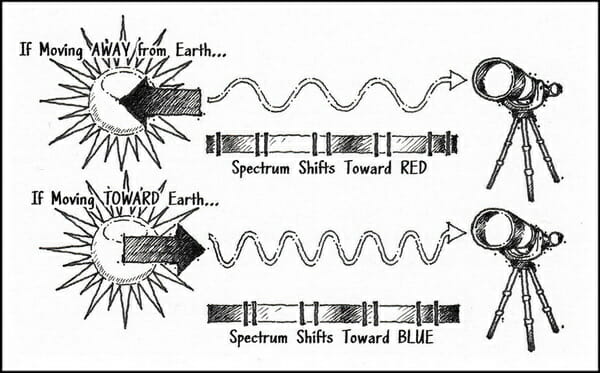A meme page of FB makes some good stuff once in a while, and so I follow the page. This comment on one of the memes caught my eye so I chose to respond to it.
- The very first chapter of the very first book of the bible has a creation myth that’s dead wrong about every detail of the history of the universe, the formation of stars and planets and the evolution of life, so you don’t know nearly as much as you think you know.
I RESPOND:
When Albert Einstein developed his general theory of relativity in 1915 and started applying it to the universe as a whole, he was shocked to discover it didn’t allow for a static universe. According to his equations, the universe should either be exploding or imploding. In order to make the universe static, he had to FUDGE his equations by putting in a factor that would hold the universe steady.
In the 1920’s, the Russian mathematician Alexander Friedman and the Belgium astronomer George Lemaitre were able to develop models based on Einstein’s theory. They predicted the universe was expanding. Of course, this meant that if you went backward in time, the universe would go back to a single origin before which it didn’t exist. Astronomer Fred Hoyle derisively called this the Big Bang — and the name stuck! [Later in his career, Fred Hoyle confirmed the expansion through work on the second most plentiful element in the universe, helium.]
Starting in the 1920’s, scientists began to find empirical evidence that supported these purely mathematical models.
PAUSE…
LET US TAKE A QUICK BREAK from this excerpt to fill in some information from another excerpt, and then we will continue:
As mathematicians explored the theoretical evidence, astronomers began to make observations confirming the expansion of the universe. Vesto Slipher, an American astronomer working at the Lowell Observatory. in Flagstaff, Arizona, spent nearly ten years perfecting his understanding of spectrograph readings. His observations revealed something remarkable. If a distant object was moving toward Earth, its observable spectrograph colors shifted toward the blue end of the spectrum. If a distant object was moving away from Earth, its colors shifted toward the red end of the spectrum.
Slipher identified several nebulae and observed a redshift in their spectrographic colors. If these nebulae were moving away from our galaxy (and one another), as Slipher observed, they must have once been tightly clustered together. In 1914, he offered these findings at a meeting of the American Astronomical Society, proposing them as evidence the universe was expanding.
A graduate student named Edwin Hubble seas in attendance and realized the implications of Slipher’s work. Hubble later began working at the Mount Wilson Observatory in Los Angeles. Using the Hooker telescope, he eventually proved Slipher’s nebulae were actually galaxies beyond the Milky Way composed of billions of stars. By 1929, Hubble published findings of his own, verifying Slipher’s observations and demonstrating the speed at which a star or galaxy moves away from us increases with its distance from Earth. This once again confirmed the expansion of the universe.
…CONTINUING…
For instance, in 1929, the American astronomer Edwin Hubble discovered that the light coming to us from distant galaxies appears redder than it should be, and this is a universal feature of galaxies in all parts of the sky. Hubble explained this red shift as being due to the fact that the galaxies are moving away from us. He concluded that the universe is literally flying apart at enormous velocities. Hubble’s astronomical observations were the first empirical confirmation of the predictions by Friedman and Lemaitre.
Then in the 1940’s, George Gamow predicted that if the Big Bang really happened, then the background temperature of the universe should be just a few degrees above absolute zero. He said this would be a relic from a very early stage of the universe. Sure enough, in 1965, two scientists accidentally discovered the universe’s background radiation — and it was only about 3.7 degrees above absolute zero. There’s no explanation for this apart from the fact that it is a vestige of a very early and a very dense state of the universe, which was predicted by the Big Bang model.
Dr. Wilson is an American astronomer, 1978 Nobel laureate in physics, who with Arno Allan Penzias discovered in 1964 the cosmic microwave background radiation (CMB)…. While working on a new type of antenna at Bell Labs in Holmdel Township, New Jersey, they found a source of noise in the atmosphere that they could not explain. After removing all potential sources of noise, including pigeon droppings on the antenna, the noise was finally identified as CMB, which served as important corroboration of the Big Bang theory.
The third main piece of the evidence for the Big Bang is the origin of light elements. Heavy elements, like carbon and iron, are synthesized in the interior of stars and then exploded through supernova into space. But the very, very light elements, like deuterium and helium, cannot have been synthesized in the interior of the stars, because you would need an even more powerful furnace to create them. These elements must have been forged in the furnace of the Big Bang itself at temperatures that were billions of degrees. There’s no other explanation.
So predictions about the Big Bang have been consistently verified by scientific data. Moreover, they have been corroborated by the failure of every attempt to falsify them by alternative models. Unquestionably, the Big Bang model has impressive scientific credentials… Up to this time, it was taken for granted that the universe as a whole was a static, eternally existing object…. At the time an agnostic, American astronomer Robert Jastrow was forced to concede that although details may differ, “the essential element in the astronomical and Biblical accounts of Genesis is the same; the chain of events leading to man commenced suddenly and sharply, at a definite moment in time, in a flash of light and energy”…. Einstein admitted the idea of the expanding universe “irritates me” (presumably, said one prominent scientist, “because of its theological implications”)
“For the scientist who has lived by his faith in the power of reason, the story ends like a bad dream. He has scaled the mountain of ignorance; he is about to conquer the highest peak; as he pulls himself over the final rock, he is greeted by a band of theologians who have been sitting there for centuries.” — Robert Jastrow
Quote from: “God and the Astronomers” (New York, NY: W.W. Norton and Company, 1992), 107. Dr. Jastrow became the founding director of NASA’s Goddard Institute for Space Studies and served as its director until his retirement from NASA in 1981. Concurrently he was a professor of Geophysics at Columbia University. Jastrow became the first chairman of NASA’s Lunar Exploration Committee, which established the scientific goals for the exploration of the moon during the Apollo lunar landings. In 1981 Jastrow left NASA to join the faculty of Dartmouth College as professor of Earth Sciences. He left Dartmouth in 1992 to take up duties as director and chairman of the Mount Wilson Institute, managing the Mount Wilson Observatory in California.
[….]
This should be put in bullet points for easy memorization:
- Albert Einstein developed his general theory of relativity in 1915;
- Around the same time evidence of an expanding universe was being presented to the American Astronomical Society by Vesto Slipher;
- In the 1920s using Einstein’s theory, a Russian mathematician (Alexander Friedman) and the Belgium astronomer (George Lemaitre) predicted the universe was expanding;
- In 1929, Hubble discovered evidence confirming earlier work on the Red-Light shift showing that galaxies are moving away from us;
- In the 1940’s, George Gamow predicted a particular temperature to the universe if the Big Bang happened;
- In 1965, two scientists (Arno Penzias and Robert Wilson) discovered the universe’s background radiation — and it was only about 3.7 degrees above absolute zero.
(See more at my post: Scientific and Anecdotal Evidence for the Beginning of the Universe)
I find this video helpful as well to show exactly what science has shown of that first book known as Genesis.
Sumerians, to the Egyptians to the Greeks, Hinduism and Buddhism and other Eastern religious movements, as well as Atheism, etc… the all posit some existence of material [matter] through all time. Eternity. The Hebrew Bible is the only religious text to posit a creation ex-nihilo – from nothing. This space/time continuum did not exist. Natural law or mathematical integers weren’t floating around ready to cause matter to pop in and out of existence. Water was not co-eternal with mind. Etc.
Just one more issue out of the many available.
Can Naturalists Explain Where Life Originated?
This video, excerpted from J. Warner Wallace’s presentation of the evidence for God, summarizes the case for Gods existence from the origin of life. Has science answered the question of life’s origin? How do philosophically natural scientists tackle the “chicken and egg” problems related to the origin of life? What is the best explanation for the information found in the genetic code? For a robust review of the collective case for God’s existence from eight pieces of evidence “inside the room” of the natural universe, please refer to God’s Crime Scene: A Cold-Case Detective Examines the Evidence for a Divinely Created Universe.
(MORE HERE from J. Warner Wallace | as well as my DNA POST)
If atheism were to have a Pope, Antony Flew would have been it for many a decade. Here we see him deal with the evidence as of late:
- “My whole life has been guided by the principle of Plato’s Socrates: Follow the evidence, wherever it leads.” After chewing on his scientific worldview for more than five decades, Flew concluded, “A super-intelligence is the only good explanation for the origin of life and the complexity of nature.” Previously, in his central work, The Presumption of Atheism (1976), Flew argued that the “onus of proof [of God] must lie upon the theist.” However, at the age of 81, Flew shocked the world when he renounced his atheism because “the argument for Intelligent Design is enormously stronger than it was when I first met it.” (MORE)
So not only is basic biology taught in the Bible, something even the most anti-God can see through nature, but #science has marched forward to reveal the accuracy of the Hebraic text over and above other religious and secular views. But even at the most basic/base view or approach to Genesis and creation vs. evolution, we have good reasons (and reason) to believe.
